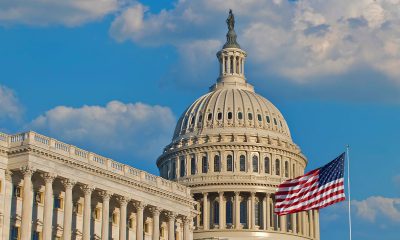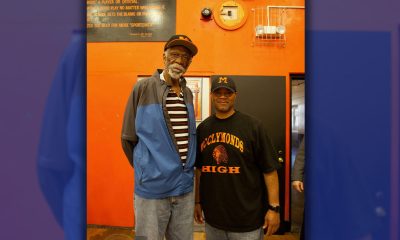Bay Area
Oakland Measure R on the March 3 Ballot Will Allow City Notices to Be Published in Diverse Newspapers
Oakland voters on March 3 — along with deciding on presidential and other crucial ballot issues — have the opportunity to vote on Measure R, which would “eliminate obsolete requirements for designation of the city’s official newspaper and require that the council establish requirements by ordinance to designate the city’s official newspaper or newspapers,” according to the ballot title and summary published by the City Attorney.
Under Measure R, the City Charter will be updated to allow the Oakland City Council to annually pick the newspaper or newspapers the publish “pending ordinances, invitations to bid, award of contracts and leases, notice of intention to grant franchises, election proceedings and other matters that require public notice.”
Currently, the charter requires that only newspapers can be designated as the city’s official newspaper if they are printed and published in the city and have a minimum daily circulation of at least 25,000 within the city.
“No newspaper that currently is circulated in Oakland meets all of the current charter requirements,” wrote City Attorney Barbara Parker in her summary of the ballot measure.
When the current law was written into the charter, there was a daily newspaper published in Oakland. Without a change in the law, the city would continue to be required to post notices in “non-local media, owned by out-of-state corporations and failing to meet the full diversity and access for our community,” wrote City Council President Kaplan.
According to the ballot argument in favor of Measure R submitted by Kaplan, local businessman Geoffrey Pete, Councilmember Noel Gallo, former newspaper publisher Robert Gammon and Legislative Director Barbara Lopez, “This measure allows the Oakland City Council to establish a thoughtful public process to adapt our noticing provisions to accommodate changing circumstance and practices through ordinance.”
“This will assist the City of Oakland in working with diverse weeklies and truly reaching all communities across our city,” the ballot argument said.
“In Oakland, our long-established daily print newspaper shut its doors in 2016,” according to the ballot argument. “As this section is memorialized in our City Charter, it requires a vote of Oakland residents to update our newspaper of record circulation requirements.”
Measure R was placed on the ballot by the City Council. Passage of the measure requires a “yes vote” of more than 50% of the votes cast.
Alameda County
Seth Curry Makes Impressive Debut with the Golden State Warriors
Seth looked comfortable in his new uniform, seamlessly fitting into the Warriors’ offensive and defensive system. He finished the night with an impressive 14 points, becoming one of the team’s top scorers for the game. Seth’s points came in a variety of ways – floaters, spot-up three-pointers, mid-range jumpers, and a handful of aggressive drives that kept the Oklahoma City Thunder defense on its heels.

By Y’Anad Burrell
Tuesday night was anything but ordinary for fans in San Francisco as Seth Curry made his highly anticipated debut as a new member of the Golden State Warriors. Seth didn’t disappoint, delivering a performance that not only showcased his scoring ability but also demonstrated his added value to the team.
At 35, the 12-year NBA veteran on Monday signed a contract to play with the Warriors for the rest of the season.
Seth looked comfortable in his new uniform, seamlessly fitting into the Warriors’ offensive and defensive system. He finished the night with an impressive 14 points, becoming one of the team’s top scorers for the game. Seth’s points came in a variety of ways – floaters, spot-up three-pointers, mid-range jumpers, and a handful of aggressive drives that kept the Oklahoma City Thunder defense on its heels.
One of the most memorable moments of the evening came before Seth even scored his first points. As he checked into the game, the Chase Center erupted into applause, with fans rising to their feet to give the newest Warrior a standing ovation.
The crowd’s reaction was a testament not only to Seth’s reputation as a sharpshooter but also to the excitement he brings to the Warriors. It was clear that fans quickly embraced Seth as one of their own, eager to see what he could bring to the team’s championship aspirations.
Warriors’ superstar Steph Curry – Seth’s brother – did not play due to an injury. One could only imagine what it would be like if the Curry brothers were on the court together. Magic in the making.
Seth’s debut proved to be a turning point for the Warriors. Not only did he contribute on the scoreboard, but he also brought a sense of confidence and composure to the floor.
While their loss last night, OKC 124 – GSW 112, Seth’s impact was a game-changer and there’s more yet to come. Beyond statistics, it was clear that Seth’s presence elevated the team’s performance, giving the Warriors a new force as they look to make a deep playoff run.
Activism
Oakland Post: Week of November 26 – December 2, 2025
The printed Weekly Edition of the Oakland Post: Week of November 26 – December 2, 2025

To enlarge your view of this issue, use the slider, magnifying glass icon or full page icon in the lower right corner of the browser window.
Activism
Oakland Post: Week of November 19 – 25, 2025
The printed Weekly Edition of the Oakland Post: Week of November 19 – 25, 2025

To enlarge your view of this issue, use the slider, magnifying glass icon or full page icon in the lower right corner of the browser window.
-

 Activism3 weeks ago
Activism3 weeks agoOakland Post: Week of November 12 – 18, 2025
-

 Activism3 weeks ago
Activism3 weeks agoIN MEMORIAM: William ‘Bill’ Patterson, 94
-

 Activism3 weeks ago
Activism3 weeks agoHow Charles R. Drew University Navigated More Than $20 Million in Fed Cuts – Still Prioritizing Students and Community Health
-

 Bay Area3 weeks ago
Bay Area3 weeks agoNo Justice in the Justice System
-

 #NNPA BlackPress3 weeks ago
#NNPA BlackPress3 weeks agoThe Perfumed Hand of Hypocrisy: Trump Hosted Former Terror Suspect While America Condemns a Muslim Mayor
-

 #NNPA BlackPress2 weeks ago
#NNPA BlackPress2 weeks agoTrump’s Death Threat Rhetoric Sends Nation into Crisis
-

 #NNPA BlackPress4 weeks ago
#NNPA BlackPress4 weeks agoProtecting Pedophiles: The GOP’s Warped Crusade Against Its Own Lies
-

 #NNPA BlackPress2 weeks ago
#NNPA BlackPress2 weeks agoLewis Hamilton set to start LAST in Saturday Night’s Las Vegas Grand Prix



























































